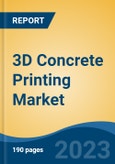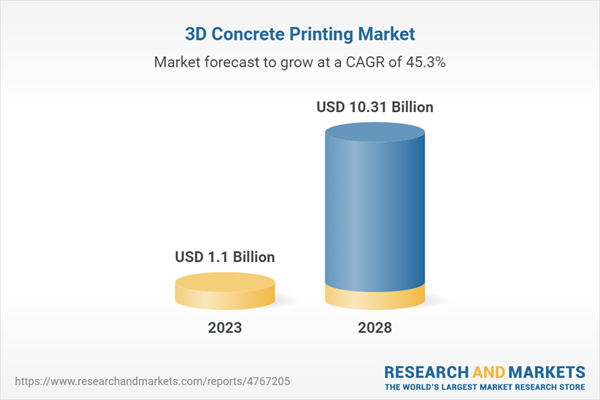Free Webex Call
The 3D Concrete Printing Market is expected to grow during the forecast period. The high cost of professional personnel in developed nations is the factor that is fuelling the expansion of the global 3D concrete printing market. Additionally, manual construction process produces construction trash, which must be gathered and destroyed. Concrete waste results in higher project costs for the contractor and higher government costs associated with collection and removal. Contrarily, 3D printing produces far less waste than the conventional method. Moreover, this technique makes it simpler and more affordable to produce large quantities of objects with irregular forms. However, the heavy initial investment cost of 3D printers, and the maintenance of their operating software and hardware, severely limits the market's expansion. Another problem limiting printing heights and sizes is that it slows down the development of the market and technology, internationally. 3D concrete printing of huge objects needs a larger setup for the printer to travel the distance. Similarly, 3D printing needs cranes or other provisions to carry the printer to the desired height. This increases the capital and operation cost of the project, owing to the larger setup of frames, thereby restraining the 3D concrete printing market growth. Speak directly to the analyst to clarify any post sales queries you may have.
10% Free customizationThis report comes with 10% free customization, enabling you to add data that meets your specific business needs.
3D concrete printing examines to construction of building structures and other aesthetical structures in diverse sizes and shapes by using automated printer. The printers are directed through feeding the program in the software. Extrusion-based 3D printing uses a screw device or pneumatic actuator to encourage material through a cartridge and into a needle or nozzle for layer-by-layer deposition. On the contrary, powder-based 3D printing is the process sustained out by depositing binding solution onto the ceramic powder bed through a print nozzle. This leads to bonding of these surface areas together to form the predesigned solid part, laying one layer at a time. Upon drying the concrete, the product is removed from the bed and excess powder is removed by air jet sprays. Ready-mix, high-density, precast, and shotcrete are the material types that are normally used for 3D printing. However, these material types are produced with various grades of materials depending on their application.
Global 3D Concrete Printing Market: Drivers & Trends
High Cost for Skilled Labor in Developed Nations:
Hiring skilled labour in developed nations, especially in Europe, incurs high cost. In addition, customized and special shapes or sizes needs skilled personnel who have experience and knowledge. High cost of labour service increases the overall budget of the projects. However, the 3D concrete printing technology helps in saving this expenditure, as the 3D printer can print error-free and complex structures. The 3D printer can be used to build complex shaped structures in mass quantity that will help in saving the labour cost. For instance, Apis Cor, a 3D printing service provider, built the largest municipal administrative building in Dubai in 2019. It hired only three workers, one 3D printer, and a crane to build the entire structure. The market for 3D printed concrete is expanding globally in large part because of this feature.Increase in Focus on Minimizing Waste Generation:
Manual construction activities generate a considerable amount of waste. Some of the concrete generally gets wasted while building walls, slabs, or pillars. However, the 3D concrete printing technology does not generate waste, as the 3D printer consists of a nozzle through which the concrete is deposited in exact amount and quantity. Therefore, minimizing waste generation and saving the cost spent on the concrete in the construction process, augment the growth of the market, globally.Mass Customization in Enhanced Architecture:
Manual construction of customized structures is notably time-consuming. In addition, the accuracy and desired output are hard to achieve manually. However, due to computerized and atomized operation, 3D concrete printing technology can print multiple numbers of structures at higher speed, and with more accuracy, compared to manual process. This acts as a major driving factor of the 3D concrete printing market.Growing Need for Affordable Housing:
The rapid growth of population worldwide is demanding new infrastructure in many large cities of South America, Africa, and India, as well as emerging nations. These countries have a housing shortage of 10 million apartments. Precast construction has proved to be the most cost-efficient, fast, and sustainable building technology to cater to large housing projects. Affordability and quality have been identified as the main objective by OECD and EU countries.Provision of affordable housing is a top priority of governments across the world. For example, in developing countries such as Kenya, the government is committed to providing affordable housing for all citizens. To cater to this need, governments are introducing many schemes and initiatives. For instance, the Indian government scheme, Pradhan Mantri Awas Yojana 2023, aims at providing affordable housing to all citizens, particularly those from economically weaker sections and low-income groups.
Global 3D Concrete Printing Market: Restraints
High Capital Cost:
The initial capital cost to set up the 3D concrete printing service needs high investment. Majorly, the cost of 3D printing machine is high due to software such as AutoCAD and SolidWorks, used to operate the 3D printer. In addition, no standard concrete is available in the market that is used for 3D printing. The composition of concrete is developed as per the geographical region and application of the 3D printing, which is one of the major restraints of the 3D concrete printing market.Limited Size of the Printer:
The 3D printer is a machine that travels along the gantry system to print the desired shape of the structure. In addition, some printers can move from one place to another, similar to the one with robotic arm. However, the size of the printers is considerably small, owing to easy and smooth displacement on the frames or on the ground. The printer, therefore, can easily print the material within its range. However, large size of walls or multi-stored buildings, needs special arrangements of additional frames to be mounted on the gantry system or sometimes cranes, that can carry the machine at a height where it normally cannot reach. This extra framing or hiring the crane to carry the 3D printer, increases the cost of the project and sometimes is not feasible, which tends to hinder the growth of the global market.Global 3D Concrete Printing Market: Opportunities
Rapid Urbanization:
Rapid urbanization and the use of cutting-edge technology in industrialized countries are anticipated to create a lucrative environment for the market expansion of 3D concrete printing. Additionally, as architects and designers learn more about the advantages of 3D printing, they are quickly shifting their preferences in favor of this technology for a range of projects, substantially contributing to the growth of the global market.For instance, in December 2019, ICON and New Story, both dealing in construction business, raised funds to build 50 3D printed houses for families to stay that have low income in Mexico. Such urbanization strategies are anticipated to boost the growth of the market during the forecast period.
Global 3D Concrete Printing Market: Challenges
Proper Material Development:
There is no common material for 3D printing technology in the market right now. Concrete is created by builders according to the strength and composition needed for certain projects. The material compositions employed in various projects that make use of 3D concrete printing technology are varied. Creating new materials takes a lot of effort and money. Therefore, it is essential to create material that can be utilized anywhere with minor compositional adjustments as needed. This poses a significant obstacle to the market's expansion. However, efforts are being made in research and development to provide standard material for 3D printing concrete.Poor Surface Finish:
3D printing is carried out layer by layer, resulting in poor surface finish. The structure loses its aestheticism. It thus becomes necessary to give manual finish to the structures for achieving smooth surface finish. This aspect acts as a major challenge for the market growth. Thus, research activities are being carried out for the advancement of nozzle from where the concrete is deposited for better surface finish.Technical Expertise:
Technical expertise regarding coding or pre-programming the path of the printer in the software and in terms of producing raw materials used for building, is crucial. Error in programming the software will lead to wrong printing, either in shape or size of the structure.Market Segments
Global 3D concrete printing market is segmented into printing type, technique, offering, end-use, and region. Based on printing type, the market is segmented into gantry system, robotic arm. Based on technique, the market is segmented into extrusion-based, powder-based. Based on offering, the market is segmented into printing services, materials. Based on end-use, the market is segmented into residential, commercial, infrastructure. Based on region, the market is segmented into North America, Asia-Pacific, Europe, South America, Middle East & Africa.Market Players
Major market players in the global 3D concrete printing market are LafargeHolcim Ltd, Skanska AB, Acciona, S.A., HeidelbergCement AG, Kier Group plc, Sika AG, Balfour Beatty plc, Foster + Partners Limited, CRH plc, Carillion plc.Report Scope:
In this report, global 3D concrete printing market has been segmented into following categories, in addition to the industry trends which have also been detailed below:3D Concrete Printing Market, By Printing Type:
- Gantry System
- Robotic Arm
3D Concrete Printing Market, By Technique:
- Extrusion-Based
- Powder-Based
3D Concrete Printing Market, By Offering:
- Printing Services
- Materials
3D Concrete Printing Market, By End-Use:
- Residential
- Commercial
- Infrastructure
3D Concrete Printing Market, By Region:
- North America
- United States
- Canada
- Mexico
- Europe
- Russia
- Germany
- United Kingdom
- France
- Italy
- Asia Pacific
- China
- India
- Japan
- Australia
- South Korea
- Middle East & Africa
- UAE
- Saudi Arabia
- South Africa
- South America
- Brazil
- Argentina
- Colombia
Competitive Landscape
Company Profiles: Detailed analysis of the major companies present in Global 3D Concrete Printing Market.Available Customizations:
Global 3D concrete printing market with the given market data, the publisher offers customizations according to a company’s specific needs.This product will be delivered within 1-3 business days.
Table of Contents
1. Product Overview
2. Research Methodology
5. Global 3D Concrete Printing Market Outlook
6. North America 3D Concrete Printing Market Outlook
7. Europe 3D Concrete Printing Market Outlook
8. Asia-Pacific 3D Concrete Printing Market Outlook
9. Middle East & Africa 3D Concrete Printing Market Outlook
10. South America 3D Concrete Printing Market Outlook
11. Market Dynamics
13. Competitive Landscape
15. About the Publisher & Disclaimer
Companies Mentioned
- LafargeHolcim Ltd
- Skanska AB
- Acciona, S.A.
- HeidelbergCement AG
- Kier Group plc
- Sika AG
- Balfour Beatty plc
- Foster + Partners Limited
- CRH plc
- Carillion plc
Table Information
| Report Attribute | Details |
|---|---|
| No. of Pages | 190 |
| Published | October 2023 |
| Forecast Period | 2023 - 2028 |
| Estimated Market Value ( USD | $ 1.1 Billion |
| Forecasted Market Value ( USD | $ 10.31 Billion |
| Compound Annual Growth Rate | 45.2% |
| Regions Covered | Global |
| No. of Companies Mentioned | 10 |









